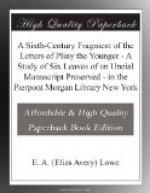“hae plinii iunioris epistolae ex uetustissimo exemplari parisiensi et restitutae et emendatae sunt opera et industria ioannis iucundi prestantissimi architecti hominis imprimis antiquarii.”
[Footnote 8: See plate XVII, which
shows the insertion in Book
VIII.]
[Footnote 9: Journal of Philology
XVII (1888), pp. 95 ff., and in
the introduction to his edition of the
Tenth Book (1889), pp. 75
ff.]
[Footnote 10: See Merrill C.P. II, p. 136.]
What more natural to conclude than that here is the very copy that Aldus prepared from the ancient manuscript and the collations and transcripts sent him by Fra Giocondo? One fact blocks this attractive conjecture: though there are many agreements between the readings of the emended Bodleian book and those of Aldus, there are also many disagreements. Mr. Hardy removed the obstacle by assuming that Aldus made changes in the proof; but the changes are numerous; they are not too numerous for a scholar who can mark up his galleys free of cost, but they are decidedly too numerous if the scholar is also his own printer.
Merrill, in a brilliant and searching article,[11] entirely demolishes Hardy’s argument. Unlike most destructive critics, he replaces the exploded theory by still more interesting fact. For the rediscovery of the Bodleian book and a proper appreciation of its value, students of Pliny’s text must always be grateful to Hardy; we now know, however, that the volume was never owned by Aldus. The scholar who put its parts together and added the variants with his own hand was the famous Hellenist Guillaume Bude (Budaeus). The parts on the supplementary leaves were done by some copyist who imitated the general effect of the type used in the book itself; Budaeus added his notes on these inserted leaves in the same way as elsewhere. It had been shown before by Keil[12] that Budaeus must have used the readings of the Parisinus; indeed, it is from his own statement in Annotationes in Pandectas that we learn of the discovery of the ancient manuscript by Giocondo:[13]
“Verum haec epistola et aliae non paucae in codicibus impressis non leguntur: nos integrum ferme Plinium habemus: primum apud parrhisios repertum opera Iucundi sacerdotis: hominis antiquarii Architectique famigerati.”
[Footnote 11: C.P. II, pp. 129 ff.]
[Footnote 12: In his edition, pp. xxiii f.]
[Footnote 13: C.P. II, p. 152.]
The wording here is much like that in the note at the end of the Bodleian book. After establishing his case convincingly from the readings followed by Budaeus in his quotations from the Letters, Merrill eventually was able to compare the handwriting with the acknowledged script of Budaeus and to find that the two are identical.[14] The Bodleian book, then, is not Aldus’s copy for the printer. It is Budaeus’s own collation from the Parisinus. Whether he examined the manuscript directly or used a copy made by Giocondo is doubtful; the note at the end of the Bodleian volume seems to favor the latter possibility. Budaeus does not by any means give a complete collation, but what he does give constitutes, in Merrill’s opinion, our best authority for any part of the lost Parisinus.[15]




